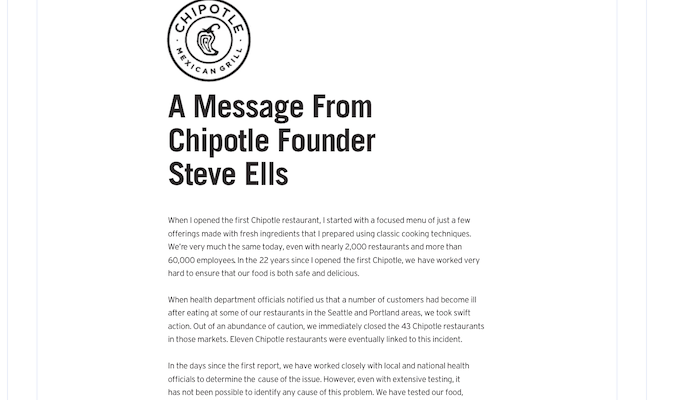If a hashtag for your brand is trending on social media, you’ve either accomplished something amazing…or your brand is being dragged through the mud in a full-fledged crisis. There’s really no in-between.
Riding the wave of a positive trend is easy. Navigating a crisis is not.
Reputation management experts, like BetterReputation, Reputation Defense Network, and Rhino Reviews, specialize in helping businesses maintain their reputation and ensure proper communications when stuff… hits the fan. If you’re facing a crisis right now and looking for inspiration on what to do, the examples below are great to look at. But every situation is different and a specialist can bring a much needed third-party perspective to an otherwise… very personal situation.
If you’re not currently navigating a crisis (we hope you aren’t), the stories below are excellent examples of what to do if you land in hot water.
Example 1–The Kendall Jenner Pepsi Ad
In April 2017, Pepsi released a commercial that shows people from all walks of life marching in the streets while Kendall Jenner watches from a doorway. She’s shooting a modeling gig, but when the protestors invite her to join them, she pulls off her wig and enters the crowd.
The protestors encounter a wall of police officers, but all it takes for them to let the crowd keep marching is—you guessed it—Kendall Jenner handing them a cold Pepsi.

The ad was met with immediate backlash.
TIME magazine called the ad “a glaring misstep.” The New York Times shared an article featuring the X post by Bernice King—daughter of Martin Luther King Jr. and Coretta Scott King—in reaction to the “tone-deaf” commercial.

What did Pepsi do? Instead of doubling down, it pulled the ad and issued an apology less than 48 hours after its release.

The brand didn’t use its honorable intentions to excuse the misguided ad. Instead, Pepsi took the blame, apologized for putting Jenner in an uncomfortable position, and immediately stopped the campaign.
These days, the world hasn’t forgotten Pepsi’s brand crisis. But it has largely forgiven it.
The Takeaway: A rapid and sincere apology goes a long way toward making things right. But your response shouldn’t stop there. Backing up your words with actionable change speaks louder than what you say in terms of repairing your reputation. Don’t just say you’ll do better. Actually do it.
Example 2–Chipotle’s E. Coli and Salmonella Outbreak
Chipotle used to be so popular that college students drove two hours in one direction to enjoy a giant burrito stuffed with their favorite ingredients.
But in 2015, it suffered a series of hits across Washington, Oregon, California, Minnesota, Ohio, New York, and Massachusetts when hundreds of people fell ill due to E. coli and salmonella after eating there.
Dozens of victims experienced symptoms severe enough to require hospitalization.
To make matters worse, the company’s stock prices plummeted. Victims, customers, and stakeholders alike weren’t happy with the situation.
However, the company rallied by strengthening its food safety requirements, replacing contaminated ingredients, and deep-cleaning its locations. Founder Steve Ells issued an open letter defending Chipotle and outlining all of the measures the company was taking to fix the problem.
An apology was also tacked on to the end of the letter.

Things got better for a few years until a norovirus outbreak at a Virginia location caused over 135 people to get sick.
The trouble didn’t end there. In 2018, a whopping 646 people contracted food poisoning caused by Clostridium perfringens bacteria after eating at an Ohio Chipotle.
Facing pressure from investors, Steve Ells stepped down from his role in 2018. Industry pro Brian Niccol took his place and worked with the Chipotle team to turn the company around—and it worked, against all odds.

Customers who ditched the restaurant during the outbreaks are returning in droves. Chipotle’s gaining new customers all the time. And the company’s stock prices have since recovered.

Most importantly, no major outbreaks have been reported in recent years.
The Takeaway: Sometimes, stronger leadership with a fresh vision is the only way to turn a brand crisis around. You (usually) can’t continue doing things the way you always have and expect different results.
Example 3–Kentucky Fried Chicken Ran Out Of Chicken
What happens when Kentucky Fried Chicken runs out of the protein that made it famous? Hilarity, apparently.
In February 2018, KFC chains in Britain ran out of chicken after a miscommunication with its supplier. Most of the nearly 900 stores in the UK had to close their doors, which should have been a disaster.
But instead of pointing fingers, the brand placed this ad in major UK newspapers:

In the apology, the company acknowledged the hassle for customers who “traveled out of their way to find we were closed.” It thanked KFC staff and franchise owners, it reported progress towards resolving the shortage, and provided a URL where customers could find updates about their local KFC.
In short? It’s genius.
KFC is so popular in the UK that some customers called their local police station to complain. The supply chain disaster could have tarnished KFC’s reputation for a long time, especially in Britain.
Instead, they turned it into something memorably funny. And that’s how it’s still viewed today.
The Takeaway: If there’s a blunder somewhere in your supply chain or you experience a long-lasting technical difficulty that leads to customer complaints, finding levity in the situation can help your customers do the same. At the same time, don’t forget to offer a heartfelt apology, acknowledge the frustration without pointing fingers, and keep customers informed of your progress toward a resolution.
Example 4–Samsung’s Exploding Note 7 Phones
In 2016, Samsung experienced a blow (pun intended) to its confidence—and market value. Shortly after its release, multiple Samsung Galaxy Note 7s caught fire. Several of them actually… exploded.

Understandably, the company had to stop making the Note 7.
It sent replacement phones to customers and lost stock value to the tune of $26 billion. The United States government even recalled the Note 7 phone and the replacements. On top of it all, both were banned from air travel.
It’s estimated that Samsung lost $17 billion in sales.
While the company’s initial response—sending more faulty phones and failing to let customers know they could explode—didn’t impress anyone, things did get better.
Samsung spent 120 days working as intensely as if the company were a startup, according to Tim Baxter, the chief executive of Samsung North America at the time.
700 engineers tested over 200,000 devices and 30,000 batteries. Three separate third-party safety auditors investigated the problem, too. In the end, the company discovered that some of its factories had been jamming batteries into ill-fitting cases, resulting in faulty (and sometimes exploding) devices.
After the crisis, Samsung put together a battery advisory board, set up new tests to identify potential points of failure, and created software that made any Note 7 still out in the world entirely unusable.
Sales have rebounded since then, and Samsung’s willingness to investigate itself and fix its mistakes helped maintain its reputation.
The Takeaway: When there’s a flaw in your product or service, make it right with your customers—then get to the root cause of the issue, put new procedures in place to prevent it from happening again, and stay on top of the changes you’ve made.
Example 5–Crockpots Probably Won’t Start a Kitchen Fire
Sometimes, a crisis happens even though a company does nothing wrong. Take the fascinating case of This Is Us and the Crockpot, for example.
In a heartbreaking 2018 episode of NBC’s hit show, viewers watched in horror as an old slow cooker ignited a fire in the Pearson home. Though the fan-favorite father character, Jack Pearson, didn’t die immediately, smoke inhalation ended his life later in the episode.
This Is Us fans held nothing back. The humble Crockpot got caught in the (understandably emotional) crossfire.

Aside from stating their newfound hatred, some vowed to throw their Crockpot away, while others expressed fear at the idea of a Crockpot fire. The fans who decided to keep their Crockpots posted on X about how theirs would forever make them feel sad and afraid.
PR nightmares don’t get much worse. Especially when you’ve done nothing wrong.
Should you apologize? It’s not your fault and there’s no reason anyone needs to be afraid of their Crockpot. So, what do you do?
This Is Us creator Dan Fogelman obviously felt bad about unintentionally dragging Crockpot through the mud–he made an X post in defense of slow cookers everywhere.
It’s unknown whether this helped or not.

The people behind Crockpot took matters into their own hands. Instead of showing their frustration, they created an X account with the handle @CrockPotCares. The brand expressed its love for Jack Pearson. It mourned with fans while gently reminding them that Crockpots are highly unlikely to start a kitchen fire.
It also teamed up with Milo Ventimiglia, the actor who plays Jack Pearson, to produce a tongue-in-cheek commercial about forgiveness. The special guest?
Milo’s own beloved Crockpot safely making chili for a Super Bowl party.

The Takeaway: Getting beat up on social media can happen for lots of reasons, including those you can’t control. If you can’t ignore it, look for ways to capitalize on the extra exposure. It often takes a lot of creativity, but it’s worth it if it means maintaining your reputation.






